Impact of Albumin Leakage on the Mortality of Patients Receiving Hemodialysis or Online Hemodiafiltration
Abstract
1. Background
2. Methods
2.1. Retrospective Observational Study
2.1.1. Patient Selection
2.1.2. Dialysis Conditions
2.2. Albumin Leakage
2.2.1. Statistical Analysis
2.2.2. Subgroup Analysis
3. Results
3.1. Comparison of Patient Survival Outcomes between the HD and OHDF Groups
3.2. Comparison in the HD Group
3.3. Comparison in the OHDF Group
3.3.1. OHDF Group
3.3.2. Pre-OHDF Group
3.3.3. Post-OHDF Group
3.4. Subgroup Analysis in Patients Age > 65 Years
4. Discussion
4.1. Nutritional Status and Dietary Intake Are Related
4.2. Albumin Leakage in Japanese-Style OHDF
4.3. Limitations
5. Conclusions
Supplementary Materials
Author Contributions
Funding
Institutional Review Board Statement
Informed Consent Statement
Data Availability Statement
Acknowledgments
Conflicts of Interest
References
- Canaud, B.; Köhler, K.; Sichart, J.-M.; Möller, S. Global prevalent use, trends and practices in haemodiafiltration. Nephrol. Dial. Transplant. 2020, 35, 398–407. [Google Scholar] [CrossRef] [PubMed]
- Kikuchi, K.; Hamano, T.; Wada, A.; Nakai, S.; Masakane, I. Predilution online hemodiafiltration is associated with improved survival compared with hemodialysis. Kidney Int. 2019, 95, 929–938. [Google Scholar] [CrossRef] [PubMed]
- Okada, K.; Michiwaki, H.; Tashiro, M.; Inoue, T.; Shima, H.; Minakuchi, J.; Kawashima, S. Effects of Japanese-style online hemodiafiltration on survival and cardiovascular events. Ren. Replace. Ther. 2021, 7, 70. [Google Scholar] [CrossRef]
- Maduell, F.; Moreso, F.; Pons, M.; Ramos, R.; Mora-Macià, J.; Carreras, J.; Soler, J.; Torres, F.; Campistol, J.M.; Martinez-Castelao, A. High-efficiency postdilution online hemodiafiltration reduces all-cause mortality in hemodialysis patients. J. Am. Soc. Nephrol. 2013, 24, 487–497. [Google Scholar] [CrossRef]
- Asci, G.; Toz, H.; Ok, E.S.; Kircelli, F.; Hur, E.; Demirci, M.S.; Demirci, C.; Duman, S.; Basci, A.; Adam, S.M.; et al. Mortality and cardiovascular events in online haemodiafiltration (OL-HDF) compared with high-flux dialysis: Results from the Turkish OL-HDF Study. Nephrol. Dial. Transplant. 2013, 28, 192–202. [Google Scholar]
- Grooteman, M.P.; Dorpel, M.A.v.D.; Bots, M.L.; Penne, E.L.; van der Weerd, N.C.; Mazairac, A.H.; Hoedt, C.H.D.; van der Tweel, I.; Lévesque, R.; Nubé, M.J.; et al. Effect of online hemodiafiltration on all-cause mortality and cardiovascular outcomes. J. Am. Soc. Nephrol. 2012, 23, 1087–1096. [Google Scholar] [CrossRef] [PubMed]
- Maduell, F.; Rodas, L.; Broseta, J.J.; Gómez, M.; Font, M.X.; Molina, A.; Montagud-Marrahi, E.; Guillén, E.; Arias-Guillén, M.; Fontseré, N.; et al. High-permeability alternatives to current dialyzers performing both high-flux hemodialysis and postdilution online hemodiafiltration. Artif. Organs 2019, 43, 1014–1021. [Google Scholar] [CrossRef]
- Belmouaz, M.; Bauwens, M.; Hauet, T.; Bossard, V.; Jamet, P.; Joly, F.; Chikhi, E.; Joffrion, S.; Gand, E.; Bridoux, F. Comparison of the removal of uraemic toxins with medium cut-off and high-flux dialysers: A randomized clinical trial. Nephrol. Dial. Transplant. 2020, 35, 328–335. [Google Scholar] [CrossRef]
- Okada, K.; Tashiro, M.; Michiwaki, H.; Inoue, T.; Shima, H.; Minakuchi, J.; Kawashima, S. Effects of high albumin leakage on survival between online hemodiafiltration and super high-flux hemodialysis: The HISTORY study. Ren. Replace. Ther. 2022, 8, 52. [Google Scholar] [CrossRef]
- Okada, K.; Tashiro, M.; Michiwaki, H.; Inoue, T.; Shima, H.; Minakuchi, J.; Kawashima, S. Comparison of survival for super high-flux hemodialysis (SHF-HD) with high albumin leakage versus online hemodiafiltration or SHF-HD with low albumin leakage: The SUPERB study. Ren. Replace. Ther. 2023, 9, 32. [Google Scholar] [CrossRef]
- Xiang, T.; Fu, P.; Zhou, L. Sarcopenia and osteosarcopenia among patients undergoing hemodialysis. Front. Endocrinol. 2023, 14, 1181139. [Google Scholar] [CrossRef] [PubMed]
- Liu, S.-X.; Wang, Z.-H.; Zhang, S.; Xiao, J.; You, L.-L.; Zhang, Y.; Dong, C.; Wang, X.-N.; Wang, Z.-Z.; Wang, S.-N.; et al. The association between dose of hemodialysis and patients mortality in a prospective cohort study. Sci. Rep. 2022, 12, 13708. [Google Scholar] [CrossRef] [PubMed]
- Abe, M.; Masakane, I.; Wada, A.; Nakai, S.; Kanda, E.; Nitta, K.; Nakamoto, H. High-performance dialyzers and mortality in maintenance hemodialysis patients. Sci. Rep. 2021, 11, 12272. [Google Scholar] [CrossRef] [PubMed]
- Miller, J.E.; Kovesdy, C.P.; Nissenson, A.R.; Mehrotra, R.; Streja, E.; Van Wyck, D.; Greenland, S.; Kalantar-Zadeh, K. Association of hemodialysis treatment time and dose with mortality and the role of race and sex. Am. J. Kidney Dis. 2010, 55, 100–112. [Google Scholar] [CrossRef] [PubMed]
- Cheung, A.K.; Rocco, M.V.; Yan, G.; Leypoldt, J.K.; Levin, N.W.; Greene, T.; Agodoa, L.; Bailey, J.; Beck, G.J.; Clark, W.; et al. Serum β-2 microglobulin levels predict mortality in dialysis patients: Results of the HEMO study. J. Am. Soc. Nephrol. 2006, 17, 546–555. [Google Scholar] [CrossRef] [PubMed]
- Rocco, M.V.; Daugirdas, J.T.; Depner, T.A.; Inrig, J.; Mehrotra, R.; Suri, R.S.; Weiner, D.E.; Greer, N.; Ishani, A.; MacDonald, R.; et al. KDOQI Clinical Practice Guideline for Hemodialysis Adequacy: 2015 Update. Am. J. Kidney Dis. 2015, 66, 884–930. [Google Scholar]
- Lin, C.-L.; Huang, C.-C.; Yu, C.-C.; Yang, H.-Y.; Chuang, F.-R.; Yang, C.-W. Reduction of advanced glycation end product levels by on-line hemodiafiltration in long-term hemodialysis patients. Am. J. Kidney Dis. 2003, 42, 524–531. [Google Scholar] [CrossRef]
- Rosner, M.H.; Reis, T.; Husain-Syed, F.; Vanholder, R.; Hutchison, C.; Stenvinkel, P.; Blankestijn, P.J.; Cozzolino, M.; Juillard, L.; Kashani, K.; et al. Classification of Uremic Toxins and Their Role in Kidney Failure. Clin. J. Am. Soc. Nephrol. 2021, 16, 1918–1928. [Google Scholar] [CrossRef]
- Beberashvili, I.; Sinuani, I.; Azar, A.; Yasur, H.; Shapiro, G.; Feldman, L.; Averbukh, Z.; Weissgarten, J. IL-6 levels, nutritional status, and mortality in prevalent hemodialysis patients. Clin. J. Am. Soc. Nephrol. 2011, 6, 2253–2263. [Google Scholar] [CrossRef][Green Version]
- Zickler, D.; Schindler, R.; Willy, K.; Martus, P.; Pawlak, M.; Storr, M.; Hulko, M.; Boehler, T.; Glomb, M.A.; Liehr, K.; et al. Medium Cut-Off (MCO) Membranes Reduce Inflammation in Chronic Dialysis Patients—A Randomized Controlled Clinical Trial. PLoS ONE 2017, 12, e0169024. [Google Scholar] [CrossRef]
- Zickler, D.; Willy, K.; Girndt, M.; Fiedler, R.; Martus, P.; Storr, M.; Schindler, R. High cut-off dialysis in chronic haemodialysis patients reduces serum procalcific activity. Nephrol. Dial. Transplant. 2016, 31, 1706–1712. [Google Scholar] [CrossRef] [PubMed]
- Prinsen, B.H.; Velden, M.G.d.S.-V.d. Albumin turnover: Experimental approach and its application in health and renal diseases. Clin. Chim. Acta 2004, 347, 1–14. [Google Scholar] [CrossRef] [PubMed]
- Giordano, M.; De Feo, P.; Lucidi, P.; Depascale, E.; Giordano, G.; Infantone, L.; Zoccolo, A.M.; Castellino, P. Increased albumin and fibrinogen synthesis in hemodialysis patients with normal nutritional status. J. Am. Soc. Nephrol. 2001, 12, 349–354. [Google Scholar] [CrossRef]
- Prinsen, B.H.; Rabelink, T.J.; Beutler, J.J.; Kaysen, G.A.; De Boer, J.; Boer, W.H.; Hagen, E.C.; Berger, R.; Velden, M.G.D.S.-V.D. Increased albumin and fibrinogen synthesis rate in patients with chronic renal failure. Kidney Int. 2003, 64, 1495–1504. [Google Scholar] [CrossRef]
- Nagai, K.; Tsuchida, K.; Hirose, D.; Michiwaki, H.; Hann, M.; Kanayama, H.-O.; Doi, T.; Minakuchi, J. The effect of albumin leakage in hemodialysis patients on redox status of serum albumin. J. Artif. Organs 2016, 19, 310–314. [Google Scholar] [CrossRef]
- Fournier, A.; Birmelé, B.; François, M.; Prat, L.; Halimi, J.-M. Factors associated with albumin loss in post-dilution hemodiafiltration and nutritional consequences. Int. J. Artif. Organs 2015, 38, 76–82. [Google Scholar] [CrossRef]
- Wolley, M.; Jardine, M.; Hutchison, C.A. Exploring the Clinical Relevance of Providing Increased Removal of Large Middle Molecules. Clin. J. Am. Soc. Nephrol. 2018, 13, 805–814. [Google Scholar] [CrossRef] [PubMed]

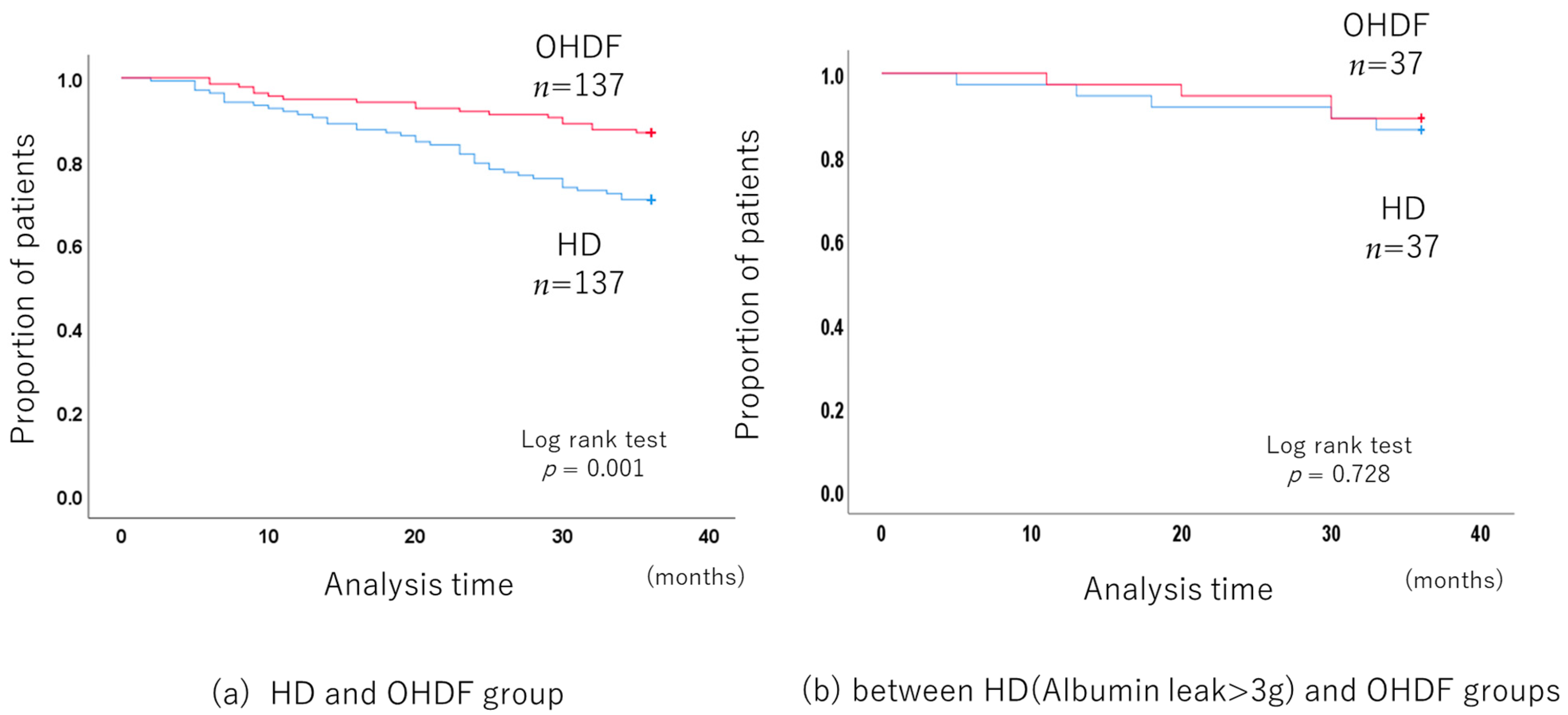
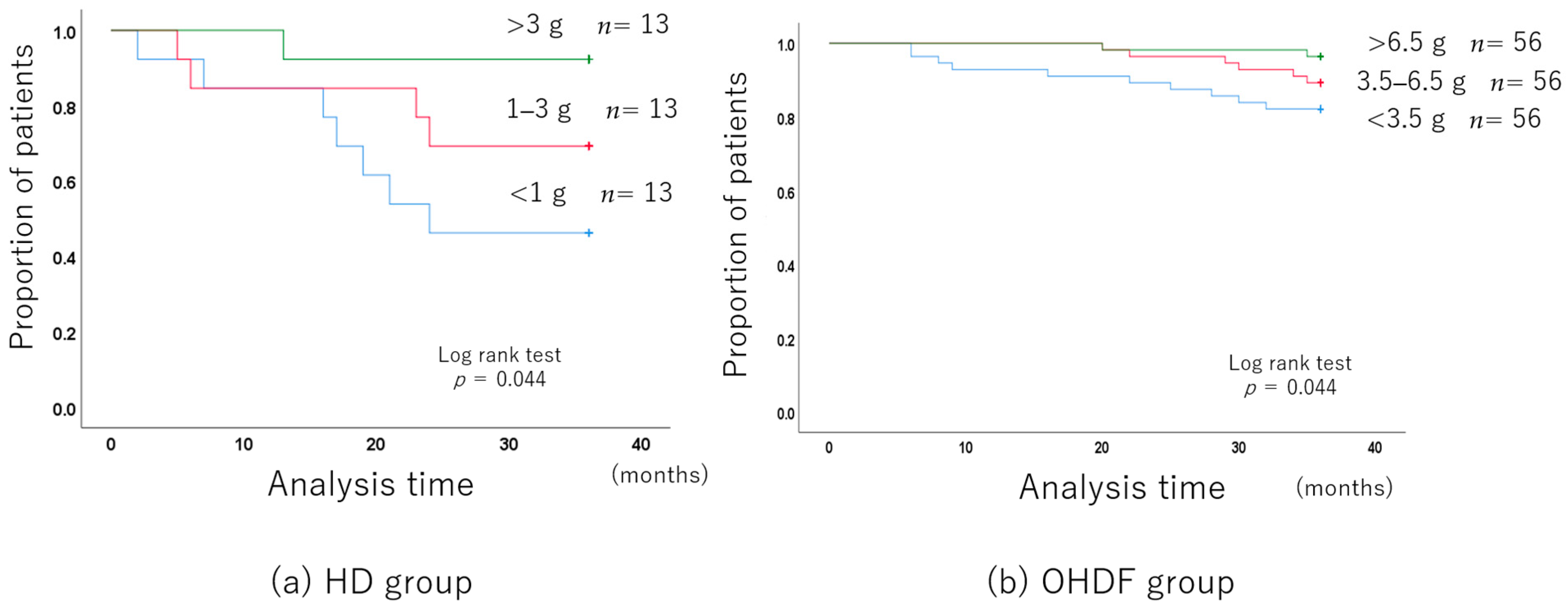
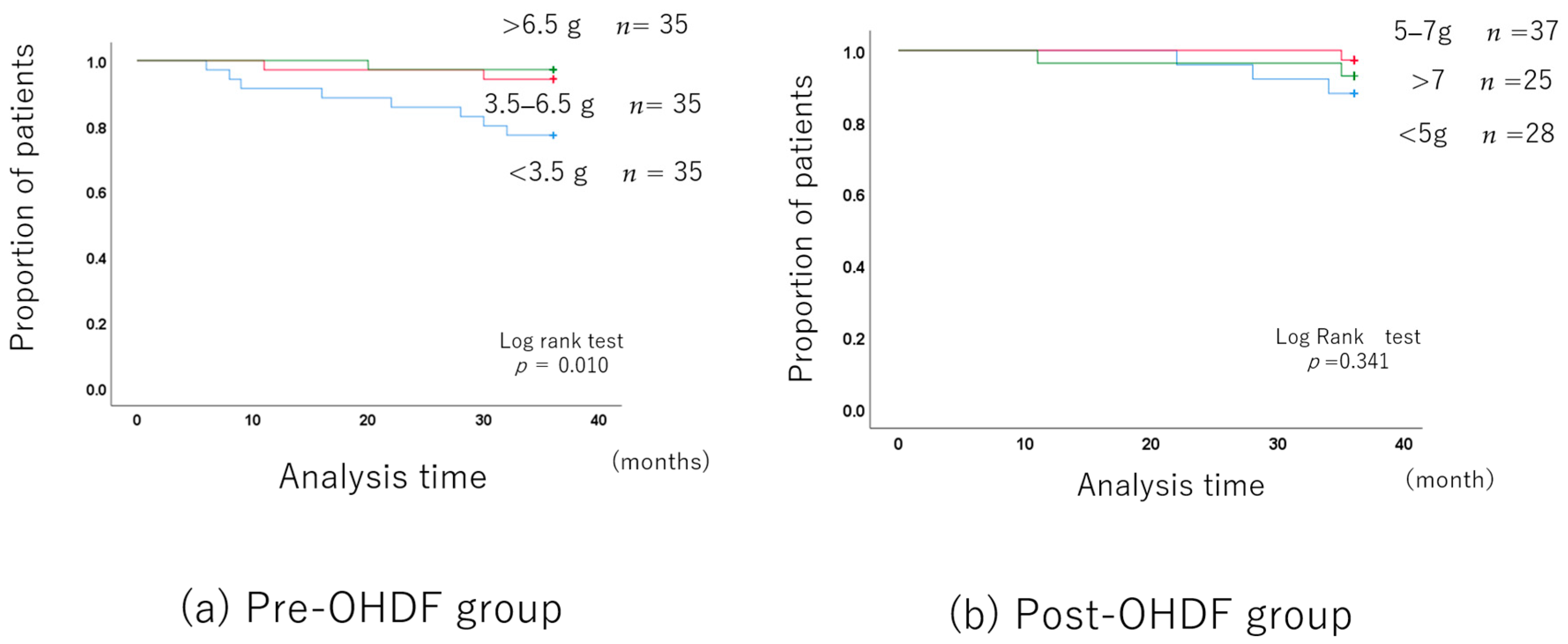
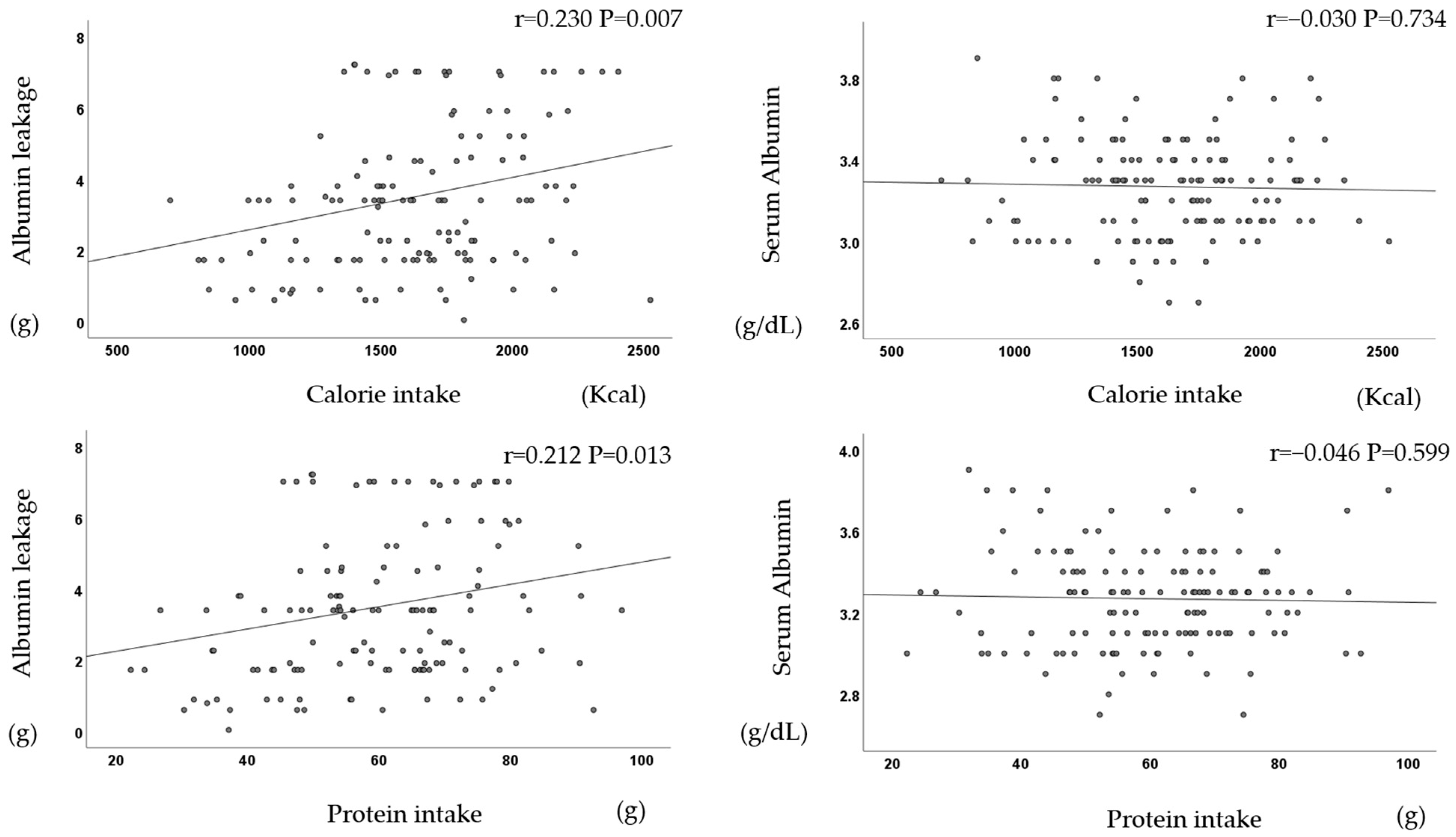
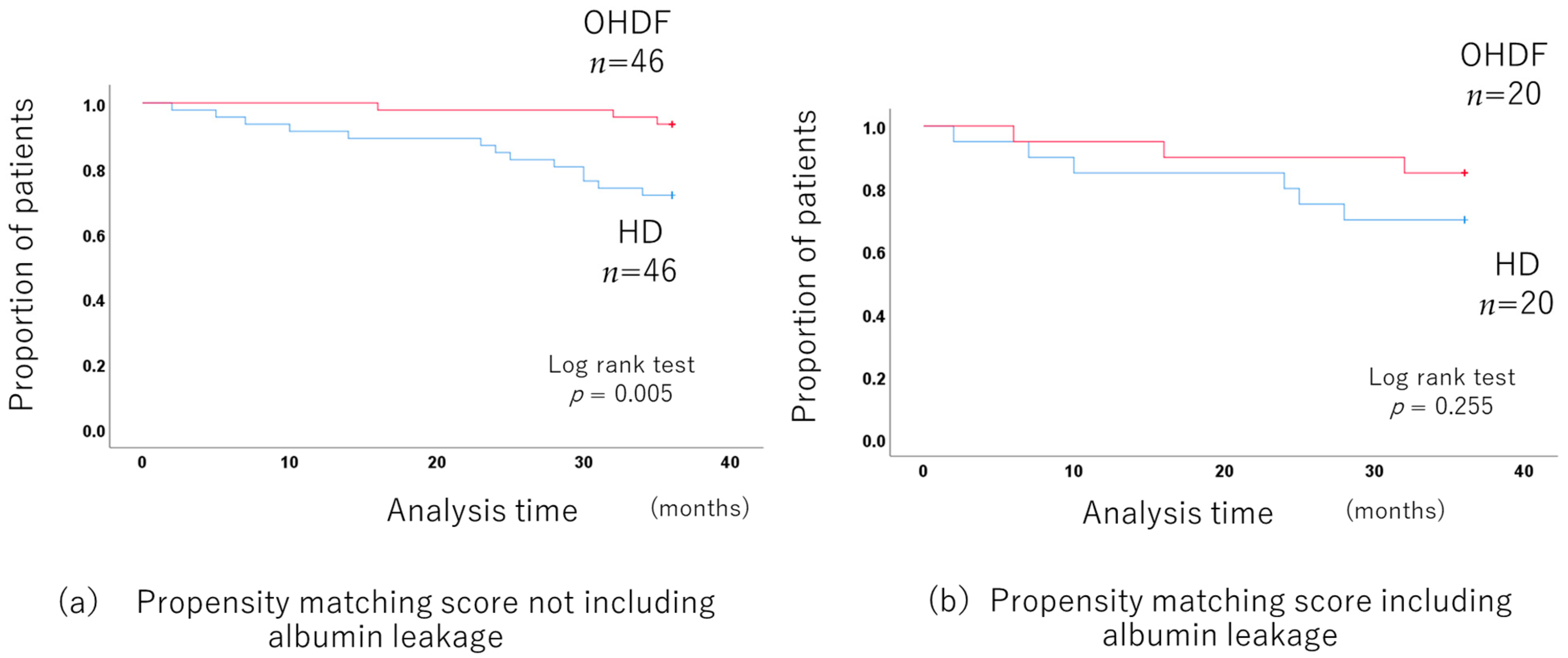
| Before Matching | After Matching | |||||
|---|---|---|---|---|---|---|
| HD (n = 159) | OHDF (n = 301) | p Value | HD (n = 137) | OHDF (n = 137) | p Value | |
| Age | 72.1 ± 11.8 | 64.2 ± 11.8 | <0.001 | 70.7 ± 11.3 | 68.9 ± 11.3 | 0.208 |
| Dialysis vintage (years) | 8.8 ± 8.9 | 11.4 ± 9.8 | 0.006 | 9.2 ± 8.9 | 9.6 ± 8.1 | 0.656 |
| Diabetes mellitus | 50/159 | 95/301 | 0.842 | 79/137 | 75/137 | 0.626 |
| BMI (kg/m2) | 21.8 ± 3.7 | 22.8 ± 3.9 | 0.005 | 21.9 ± 3.8 | 22.5 ± 3.9 | 0.168 |
| Blood pressure (mmHg) | 143 ± 25 | 143 ± 25 | 0.864 | 143 ± 25 | 141 ± 25 | 0.641 |
| Kt/V | 1.61 ± 0.33 | 1.57 ± 0.30 | 0.174 | 1.61 ± 0.34 | 1.57 ± 0.29 | 0.408 |
| nPCR (g/kg/day) | 0.83 ± 0.20 | 0.87 ± 0.15 | 0.035 | 0.84 ± 0.20 | 0.86 ± 0.16 | 0.513 |
| Hb (g/dL) | 11.0 ± 1.3 | 11.4 ± 1.1 | 0.004 | 11.1 ± 1.3 | 11.1 ± 1.1 | 0.764 |
| Alb (g/dL) | 3.27 ± 0.39 | 3.37 ± 0.27 | 0.006 | 3.31 ± 0.36 | 3.33 ± 0.26 | 0.513 |
| Ca (mg/dL) | 8.7 ± 0.8 | 8.8 ± 0.7 | 0.161 | 9.5 ± 0.7 | 9.4 ± 0.7 | 0.444 |
| P (mg/dL) | 5.2 ± 1.6 | 5.5 ± 1.4 | 0.031 | 5.3 ± 1.5 | 5.2 ± 1.2 | 0.704 |
| HS-CRP (mg/dL) | 2.28 ± 2.77 | 2.42 ± 2.86 | 0.604 | 2.36 ± 2.84 | 2.67 ± 3.04 | 0.393 |
| β2-MG (mg/L) | 27.5 ± 7.1 | 27.6 ± 6.2 | 0.870 | 27.6 ± 7.1 | 27.0 ± 6.5 | 0.433 |
| Albumin leakage (g) | 2.14 ± 1.16 | 4.92 ± 2.79 | <0.001 | 2.23 ± 1.13 | 4.38 ± 2.62 | <0.001 |
Disclaimer/Publisher’s Note: The statements, opinions and data contained in all publications are solely those of the individual author(s) and contributor(s) and not of MDPI and/or the editor(s). MDPI and/or the editor(s) disclaim responsibility for any injury to people or property resulting from any ideas, methods, instructions or products referred to in the content. |
© 2024 by the authors. Licensee MDPI, Basel, Switzerland. This article is an open access article distributed under the terms and conditions of the Creative Commons Attribution (CC BY) license (https://creativecommons.org/licenses/by/4.0/).
Share and Cite
Tashiro, M.; Okada, K.; Tanaka, Y.; Michiwaki, H.; Shima, H.; Inoue, T.; Doi, T.; Minakuchi, J. Impact of Albumin Leakage on the Mortality of Patients Receiving Hemodialysis or Online Hemodiafiltration. J. Clin. Med. 2024, 13, 1865. https://doi.org/10.3390/jcm13071865
Tashiro M, Okada K, Tanaka Y, Michiwaki H, Shima H, Inoue T, Doi T, Minakuchi J. Impact of Albumin Leakage on the Mortality of Patients Receiving Hemodialysis or Online Hemodiafiltration. Journal of Clinical Medicine. 2024; 13(7):1865. https://doi.org/10.3390/jcm13071865
Chicago/Turabian StyleTashiro, Manabu, Kazuyoshi Okada, Yusaku Tanaka, Hiroyuki Michiwaki, Hisato Shima, Tomoko Inoue, Toshio Doi, and Jun Minakuchi. 2024. "Impact of Albumin Leakage on the Mortality of Patients Receiving Hemodialysis or Online Hemodiafiltration" Journal of Clinical Medicine 13, no. 7: 1865. https://doi.org/10.3390/jcm13071865
APA StyleTashiro, M., Okada, K., Tanaka, Y., Michiwaki, H., Shima, H., Inoue, T., Doi, T., & Minakuchi, J. (2024). Impact of Albumin Leakage on the Mortality of Patients Receiving Hemodialysis or Online Hemodiafiltration. Journal of Clinical Medicine, 13(7), 1865. https://doi.org/10.3390/jcm13071865





